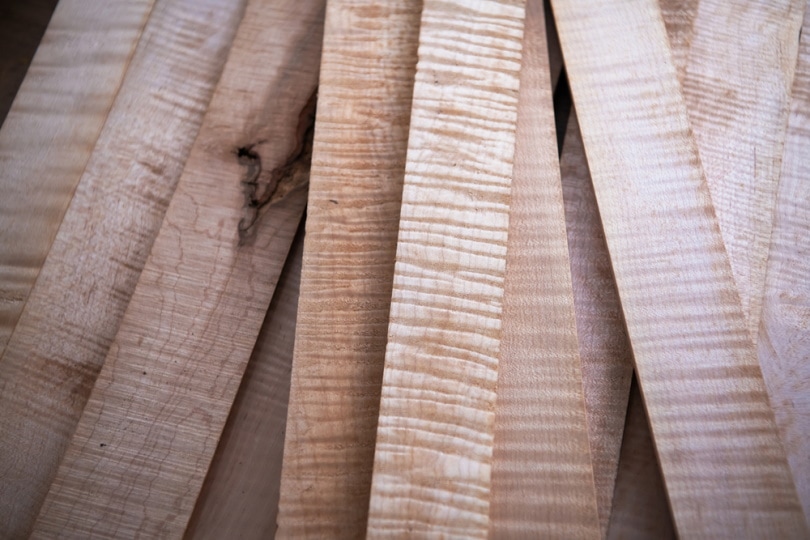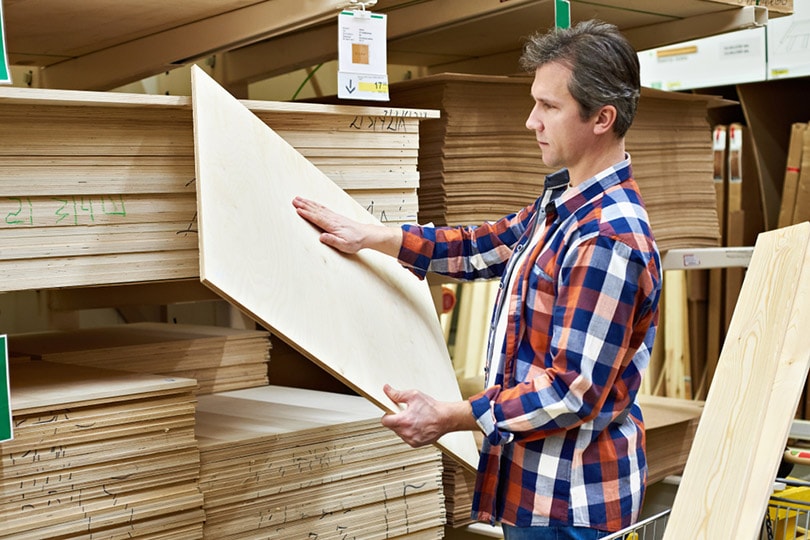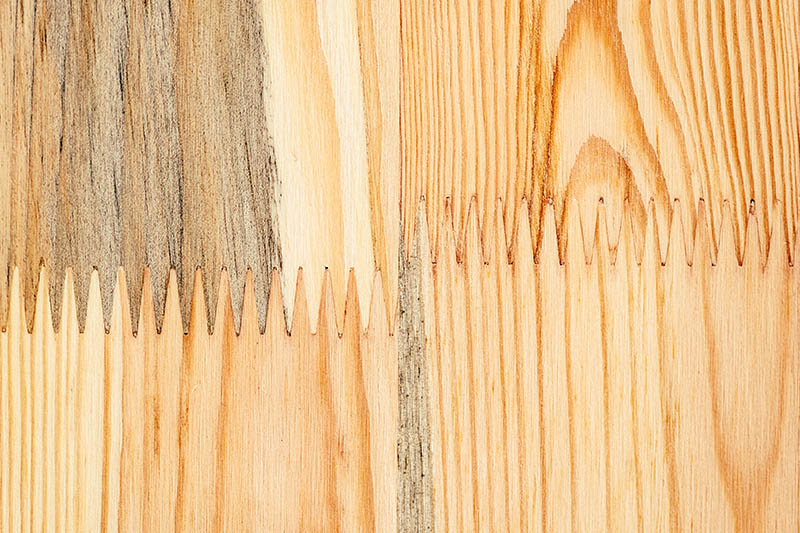MDF vs. Solid Wood: Pros & Cons + When to Use
-
- Last updated:

As a homeowner looking to build, renovate, or simply give your home’s interior and exterior furniture a fresh makeover, one of the most important considerations is the type of materials used. Different materials are used in paneling applications, including solid wood, plywood, and MDF.
Most architects and interior designers often opt for solid wood as their primary material for construction. Yet, technological advancements have prompted the engineering of cheaper wood materials, which are studier and more unique. Today, materials like MDF (medium density fiberboard) are used for making furniture, shelves, and bathroom and kitchen cabinets. However, all materials are equally capable of giving your home an elegant look.
So, how exactly does MDF compete with solid wood for home furnishings, and which one is worth buying? This article will give you an overview of these two most commonly utilized materials: wood and MDF. It will also highlight the benefits and drawbacks of both, as well as factors you should consider while choosing one.

Overview of Solid Wood

Also known as the usual variety or natural wood, solid wood is the normal wood that people refer to. It is milled from trees, such as maple, cherry, oak, and walnut. Solid wood has been used for centuries to build homes and for interior and exterior furnishings. This type of wood is a popular construction material due to its versatility. It can make doors, cabinets, and sofas, among other things. It also gives a house structure when used as a pillar.
Usually, solid wood doesn’t require any extra painting on the surface to make it more attractive. It features a natural beauty that makes it appealing for decorative purposes. So, you don’t have to wax or add resin or an adhesive to the surface. After dried logs are cut, the bark is removed, and the surface is sanded to give it a smooth finish.
However, you can paint or stain it to attenuate its natural look. Solid wood can also be shaped and curved to create unique details. This wood type can be categorized into different types, yet the most reliable solid woods for construction are plywood and finger joint pine.
Types of Solid Wood
Plywood

Plywood is considered the standard of solid wood and is generally used to make cabinets, beds, tables, and shelves, among others. It also builds ceilings and walls. Plywood has been around for years now. However, it became mainstream after the industrialization era, which prompted large-scale manufacturing.
Plywood is derived from tree trunks where the tree is cut and the bark removed. After the surface has been smoothened, the tree trunk is rolled against a sharp edge to produce thin sheets of plywood. Then, the sheets are layered over each other at a perpendicular angle. Each ply has to be aligned with the width of the ply above and below. The thin sheets are then combined with an adhesive mixture to ensure the plywood is sturdy and intact.
The final product features beautiful patterns often used in home decorations without needing any paint job. Plywood is widely used across the United States to construct houses and make furniture. It is a favorite among interior designers because it is considered top quality.
Finger Joint Pine

The other solid wood variety commonly utilized in building and construction is finger joint pine. As the name suggests, this type of wood is made by joining two different wood pieces in an interlocking way. Hence, finger joint pine makes long pieces of wood or blocks out of small wood pieces.
It is prepared by creating finger-like projections at one corner of the wood, as well as the corresponding projections on the wood that you wish to join. Sometimes a glue solution is added to the joints to ensure that the joints are strong enough to avoid breaking during transportation or installation.
Unlike the plywood variety, you must paint finger joint pine because the wood used is of different varieties and may not match in terms of color or texture. So, if you don’t paint, your wood may have an absurd and unappealing look.
- Strength and Durability: Solid wood is stable and can withstand heavy weights. Due to its durability and strength, you can hammer a nail on this wood type without worrying if you will damage the surface. Also, the more layers used on plywood, the more robust it gets. The durability and strength are determined by the type of tree used in the wood layers.
- Aesthetic Appeal: If you are looking for appealing materials for your internal furnishings, solid wood is by far the most beautiful and elegant material you can use. They feature beautiful grains, which cannot be replicated in any engineered wood, thus increasing the aesthetic value of your décor when used in your home.
- Available in Different Varieties: Solid wood retails in several shapes and sizes, readily available in the wood market. Whether plies, crowns, or pillars, you can find almost any solid wood piece for your construction projects. Furthermore, you can increase the size of solid wood by joining the wood planks using the standard finger method.
- Expansion and Construction: As a porous material, solid wood is susceptible to temperature and humidity fluctuations. In dry conditions, it will shrink and crack. In contrast, it will expand and swell in moist conditions causing your furniture to warp if not installed properly.
- Prone to Water Damage: If water from leaks or flooding gets on the surface of your solid wood, it will absorb the moisture and encourage mold. To prevent this, consider applying a sealant on the surface.
- Cost: Solid wood may not be suitable if working on a tight budget. It is one of the most expensive materials in the market. It takes longer to fabricate and requires regular maintenance.

Overview of MDF Wood

MDF stands for medium-density fiberboard. Also known as engineered wood, MDF is made from shredded recycled wood combined with adhesives and compressed under high pressure to produce a grainless and smooth surface. Unlike solid wood, you may have to paint over the surface because the final MDF product is never aesthetically appealing.
For the last few years, MDF has gained popularity as a wood substitute with myriad applications. It differs from common solid wood in the structure. However, it is made from finely ground wood but not synthetic materials as most people assume. The structure of MDF consists of wood fibers usually gathered from leftovers after processing in the furniture industries.
Applications
Since their inception, MDF applications have drastically changed. Today this material is used to make windows, doors, tables, cabinets, shelves, and other items. Even though most people believe that MDF was banned in the USA in the late 90s due to health complications, it is still widely used across many homes.
The health implications came about due to the presence of formaldehyde, which is carcinogenic when consumed. However, the dust produced by MDF is not harmful to carpenters because it is coated with paint and a primer to limit the chances of anyone consuming it.
- Will Not Warp and Crack: Unlike Solid wood, MDF doesn’t crack or warp. Sure, it is made of wood that expands and contracts with temperature changes, but it changes form and shape as a unit, limiting the chances of warping. This also reduces the chances of damaging the paint applied on the surface.
- Cheaper: As earlier mentioned, MDF is cheaper than solid wood because it is made from leftovers of recycled wood, which is cheap or might not cost anything at all. So, MDF is a budget-friendly option—usually half the cost of plywood.
- Environment Friendly: MDF is a favorite among environmentalists because it uses leftover and recycled wood that would have otherwise filled up the landfill. Therefore, MDF has no carbon footprint and is great for the environment. Furthermore, large-scale production of MDF will reduce the number of trees felled, thus reducing deforestation.
- Retails in a Variety of Sizes: Since MDF is engineered wood, it can be produced in different shapes and sizes to suit different needs.
- Smoother Surface: Since MDF features tiny, refined particles, its surface is always smooth and refined. This allows carpenters to make fair and smooth cuts at the edges, which is virtually impossible on plywood.
- Sags Overtime: MDF tends to sag when a lot of weight is placed on the surface. Once MDF has sagged, it will not be able to withstand the weight of any heavy objects and will need replacement. Fortunately, it takes a significant amount of time to sag. So, the price you pay will be worth it.
- Is Not Water Resistant: Since MDF is made from small wooden particles, it easily absorbs water, weakens, crumbles, and eventually breaks down. So, even if a single point gets wet, your furniture will get damaged. To prevent crumbling, apply a water-resistant primer on the surface before installation.
- Cannot Handle Large Nails: When nails are hammered into the MDF surface, they expose the interior, and that doesn’t look good after installation. So, if you really must use nails, opt for the smaller ones because larger nails will produce an unappealing finish.
- Scratches Easily: The tiny particles used in MDF also make it susceptible to scratches. When solid wood gets scratched, you can fix the surface by sanding it. However, the same doesn’t apply to MDF wood. So, if you live in an area prone to harsh weather, MDF is not suitable as a construction material.

How to Decide Between MDF Wood and Solid Wood
When it comes to choosing the type of wood to use for your construction project, apart from solid wood and MDF wood, there are other considerations, such as:
- Whether to use laminates or to paint
- To use contemporary or traditional materials
- using polished or brushed surface
These are all equally important aspects, but the materials used for construction are the most essential because it determines the maintenance, performance, and lifespan of your furniture.
One of the most frequently asked questions in the furniture industry is if wood or MDF is better for construction. It is a concern that interior designers, architects, and homeowners often raise. To make a worthwhile purchasing decision, choose one based on the following factors.
- Price: As earlier mentioned, MDF is the most budget-friendly option of the two. However, if you are not strapped for cash, go for solid wood.
- Durability: When properly installed and maintained, solid wood is more durable than MDF. However, if you are looking for a temporary fix or replacing an aged-out piece of wood, MDF is a better option.
- Environmental conservation: If you are an environmentally conscious person and prefer using materials that don’t harm the environment, you can opt for MDF. It recycles wood and has zero carbon footprint.
- Application: How you use your materials will determine your choice. If you simply want to install a bedroom or dining room cabinet, MDF is a better choice. However, if your cabinets need installation in moisture-rich environments, such as the bathroom or kitchen, plywood is a safer bet. MDF is also not recommended for use in outdoor furniture because it can easily get damaged.

The Final Verdict
If you are still unsure whether to choose MDF or solid wood, your choice will be determined by your specific needs and preferences. As you may have gathered, there is no winner. You can use solid wood and MDF on whatever you are making, be it furniture, walls, or ceilings.
If you simply want to renovate your kitchen or add a new bookshelf in your living area, you will want to use MDF wood. It offers more control in terms of aesthetics and design. But if you intend to make pillars for your house or build a big wardrobe that can handle many shelves and clothing, solid wood is a better choice. Natural wood also makes better designs and stately-looking furniture that oozes elegance and sophistication.
While both types of wood can be used in construction, they have specific benefits and drawbacks. They only differ in terms of size, shape, placement, budget, and appearance. However, the choice is still up to you.
- https://moldblogger.com/
- https://www.compositepanel.org/sustainability/
- https://www.periodmouldings.co.uk/blog/pros-and-cons-mdf-vs-solid-wood-skirting/
- https://donspianoplace.ngontinh24.com/article/mdf-vs-wood-why-mdf-has-become-so-popular-for-cabinet-doors
- https://www.thewoodworkplace.com/mdf-vs-pine-crown-molding/
Featured Image Credit: (L) Dragan-drmr_foto, Shutterstock | (R) Potashev Aleksandr, Shutterstock
Contents

